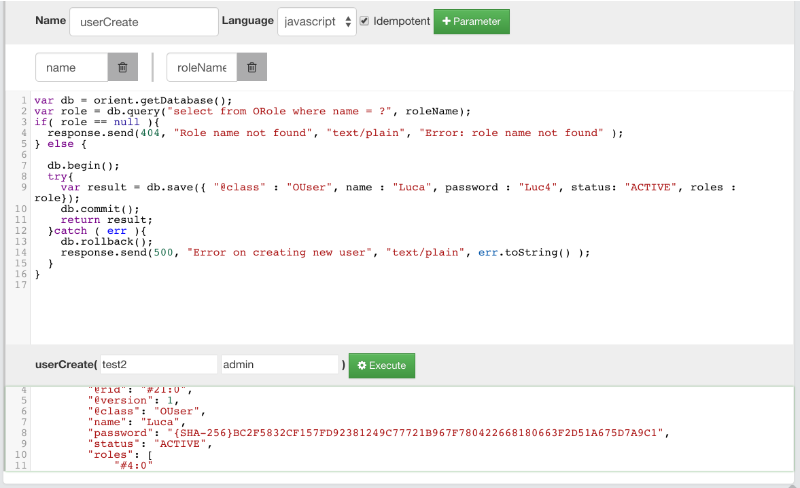Accessing the Database from a Function
When you create a function for OrientDB, it always binds the special variable orient to allow you to use OrientDB services from within the function. The most important methods are:
| Function | Description |
|---|---|
orient.getGraph() |
Returns the current transactional graph database instance. |
orient.getGraphNoTx() |
Returns the current non-transactional graph database instance. |
orient.getDatabase() |
Returns the current document database instance. |
Executing Queries
Queries are idempotent commands. To execute a query from within a function, use the query() method. For nstance,
return orient.getDatabase().query("SELECT name FROM OUser");
Queries with External Parameters
Create a new function with the name getUserRoles with the parameter user. Then use this code:
return orient.getDatabase().query("SELECT roles FROM OUser WHERE name = ?", name );
Here, the function binds the name parameter as a variable in JavaScript. You can use this variable to build your query.
Executing Commands
OrientDB accepts commands written in any language that the JVM supports. By default, however, OrientDB only supports SQL and JavaScript.
SQL Commands
Execute an SQL command within the function:
var gdb = orient.getGraph();
var results = gdb.command( "sql", "SELECT FROM Employee WHERE company = ?", [ "Orient Technologies" ] );
The command returns an array of objects:
- When it returns vertices: The result is an
OrientVertexinstance. - When it returns edges: The result is an
OrientEdgeinstance. - When it returns records: The result is an
OIdentifiable(or, any subclass of it) instance.
Creating Repository Classes
Functions provide an ideal place for developing the logic your application uses to access the database. You can adopt a Domain-driven design approach, allowing the function to work as a repository, or as a Data Access Object.
This provides a thin (or thick, if you prefer) layer of encapsulation which may protect you from database changes.
Furthermore, each function is published an dreachable via the HTTP REST protocol, allowing the automatic creation of a RESTful service.
Examples
Below are some examples of functions to build a repository for OUser records:
function user_getAll() {
return orient.getDatabase().query("SELECT FROM OUser");
}
function user_getByName( name ){
return orient.getDatabase().query("SELECT FROM OUser WHERE name = ?", name );
}
function user_getAdmin(){
return user_getByName("admin");
}
function user_create( name, role ){
var db = orient.getDatabase();
var role = db.query("SELECT FROM ORole WHERE name = ?", roleName);
if( role == null ){
response.send(404, "Role name not found", "text/plain", "Error: role name not found" );
} else {
db.begin();
try{
var result = db.save({ "@class" : "OUser", name : "Luca", password : "Luc4", status: "ACTIVE", roles : role});
db.commit();
return result;
}catch ( err ){
db.rollback();
response.send(500, "Error on creating new user", "text/plain", err.toString() );
}
}
}
